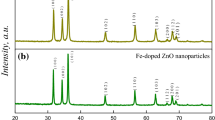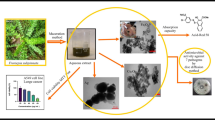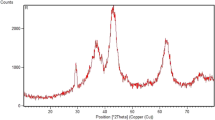Abstract
Novel magnesium 1,2,4-triazole-1-carbodithioates were sonochemically synthesized as water-dispersable nanoparticles owing to their water insolubility. The two-step reaction protocol was followed to synthesize the novel triazole ligand system for complexation with magnesium metal due to its low biological toxicity. Different concentrations of Poly Vinyl Pyrrolidine were used to stabilize and standardise the size of nanoparticles, which were characterised by TEM analysis. UV–Visible and infrared spectroscopies were used to analyse the metal ligand interaction, and CHNS analysis was used to propose the structure of the metal complex. The spore germination inhibition technique was used to evaluate the antifungal potential of synthesized nano-complexes against two phytopathogenic test fungi viz. A. alternata and F. moniliforme. The nanoparticles had inflicted moderate in vitro inhibition of fungal growth, which was comparable to standard fungicide Indofil M-45. The in silico toxicity of the compounds was made using the Toxtree analysis software that indicated the compounds belong to class III group of toxicity, which was same as that of commercial standards of DTC.
Similar content being viewed by others
Avoid common mistakes on your manuscript.
Introduction
The field of bioinorganic chemistry, which deals with the study of role of metal complexes in biological systems, has opened a wide horizon for scientific research (Haas and Franz 2009). Complexation has immense potential to augment the bioactivities of organic compounds (D’hooghe and De Kimpe 2006; Cao et al. 2005), which are influenced by the metal ions, the ligands and the structure of the complex (Katari and Srinivas 2014). Biologically relevant metal complexes have several other requirements in terms of their synthetic design, viz, their high thermodynamic stability to deliver the metal to the active site, their hydrolytic stability by which metal ion undergoes ligation or de-ligation reactions (Shoaib et al. 2013), their molecular weight which helps them to reach the proper target site in the body. Applicability of the metal complexes sometimes suffered due to the insolubility of complexes, which marks negative impact on their biological evaluation (Daoud et al. 2014). Nanotechnology seems to provide solution to this non-favour in terms of reduction of the size of complexes to nanoscale (Davies 2006). Furthermore, the size of nanoparticles imparts diversified topological parameter and thereby, improves their bioactivity as compared to the molecules in bulk, thus, providing an additional benefit of greater effectiveness even at lower doses (Vijaya et al. 2015).
Keeping the above factors in mind and bio-potential of 1,2,4-triazole as antifungals (Zan et al. 2002) along with low mammalian toxicity, degradability, multisite mode of action and ease of preparation of carbodithioates (Leka et al. 2013; Qin et al. 2012), the novel hetero-organic ligand system 1,2,4-triazole-1-carbodithioates were synthesized and complexed with non toxic magnesium metal to see the effect of complexation on the bioactivity of the molecules. However, the insolubility of magnesium 1,2,4-triazole-1-carbodithioates in all the solvents prompted us to utilize the power of nano-synthesis of these complexes. In the present paper, we have reported the synthesis and characterization of water dispersible nanoformulation of magnesium 1,2,4-triazole-1-carbodithioates and their antifungal evaluation against various phytopathogens.
Results and discussion
Chemistry
The two-step reaction protocol involved the synthesis of sodium 1H-1,2,4-triazole-1-carbodithioate, followed by an addition of magnesium chloride to give the required DTC complexes, under ultrasonication. Different concentrations of PVP were applied to obtain the stable and well-coated nanoparticles of proper size distribution. Out of the various test concentrations of PVP, addition of 0.5 g in 100 ml of solution gave the best results with uniform size distribution, that were reproducible. However, an addition of higher amount of PVP leads to the formation of large coating material around the nanoparticles.
Electronic spectral analysis
The whitish coloured Mg(II) complexes of triazole-1-carbodithioates showed peaks with λ max values at 300 and 380 in case of 1:1 complex and 320 and 400 in case of 1:2 complex. The shift in λ max observed for the two peaks towards the visible region may be attributed to the complex formation (Fig. 1). These peaks corresponded to the π–π* transistion of S–C–S chromophore in triazole complex (Franchini et al. 1985).
CHNS analysis
The elemental analysis helped to propose the structure of complexes with two different concentrations of ligands. The results are as shown in Table 1.
On the basis of above results the proposed structures of the magnesium complexes are as under in (Fig. 2).
IR spectral analysis
In the IR spectra of sodium salt of DTC, the strong band observed at 1000 cm−1 is due to stretching vibration of C–S bond. The other bands corresponding to bending vibrations of C–S and S–C–S appeared at 668 and 880 cm−1 (Fig. 3).
For observing the IR spectra of the nanoparticles, the nanoemulsion was centrifuged at 4000 rpm for 1 min giving at least 2 cycles of washing (using 25 °C deionised water). It was finally centrifuged for the third time, and was dried at room temperature in a vacuum system. The IR spectra of the nanoparticles revealed an additional stretching in C–S and S–C–S bond at 574 and 676 cm−1 along with strong band for C=S at 978 cm−1, giving an evidence of the formation of the complexes (Fig. 4).
TEM analysis
Transmission electron microscopy (TEM) was used to measure the nanoparticle core dimensions. At 0.5 g PVP, surface-capped magnesium 1H-1,2,4-triazole-1-carbodithioate nanoparticles appeared uniformly spherical, had an average particle diameter within a range of 50–100 nm. There was no obvious aggregating phenomenon for about six months, thus, revealing good particle size stability. PVP had been observed to get adsorbed on the surface of the nanoparticles, thereby reducing their surface energy and preventing them from aggregation. Thus, the nano aqua emulsion had well-controlled particle size and an improved dispersion capability in water (Fig. 5; Table 2).
In vitro antifungal studies
In the current study, some synthesized complexes were tested against phytopathogenic fungal strains such as A. alternata and F. moniliform. Indofil M-45 was used as reference drug for fungi. The effective concentration, at which 50% inhibition takes place (EC50), was noted by spore germination inhibition technique (Table 3). The complexes of 1:2 metal to ligand ratio had shown greater in vitro antifungal activity against fungal strains than 1:1 complexes. This is expected to further increase by using the metal having coordination number greater than four.
In comparison to standard Indofil M-45, that makes an insoluble formulation, our water based formulation is much more environment friendly, that decreases the use of organic solvents and increases the wettability, dispersiblity and penetration ability of the pesticide. Further, the potential can be enhanced by using other surface active agents, that can enhance the activity of water based formulation.
Toxtree analysis
Estimation of toxic hazards by Cramer rules was carried out using Toxtree v.2.6.6 software (Puratchikody et al. 2012). This estimate showed that compounds belong to class III level of toxicity, which was found to be same as that of the toxicity level of standards fungicides.
Conclusion
Resistance measures call for novel molecules of improved fungitoxic profile. The results of antifungal evaluation of these nanoparticles, owing to their reduced toxicity profile, demand their further exploration by complexation with other metals of higher coordination numbers as well as expanding their evaluation against more phytopathogens, so that they could be developed into non-toxic bioactive leads. The work related to above is underway and will be reported soon.
Experimental
The reagents and solvents were of analytical grade, purchased from CDH Company. Solvents used were of analytical reagent grade and purified by simple distillation. Double distilled water was used for preparation of all the solutions. The multiwave ultrasonicator operating at 42 kHz was used. Melting points were checked in open capillaries using electronic melting point apparatus and were uncorrected. The UV–Visible spectra were recorded with a double beam spectrophotometer, having a path length of 1 cm. The IR spectra were recorded on a Perkin Elmer FT-IR spectrometer using KBr disc. Elemental analyses were done on Vario EL, CHNOS elemental analyzer. Particle size was analysed by employing Transmission electron microscope model Hitachi Hi-7650 at 100 kV acceleration voltages in HC mode using water as dispersion medium. Toxtree v2.6.6, an open-source software application was used to study toxicity of designed compounds.
Procedure for synthesis of sodium 1H-1,2,4-triazole-1-carbodithioate
0.05 mol of 1,2,4-triazole (3.45 gm) was dissolved in 20 ml of methanol in a clean flask which was placed in an ice bath. To this ice cold solution was added 5 ml of 10 N sodium hydroxide. Carbon disulphide (0.05 mol, 3.5 ml) was added to the same flask, drop-wise, with constant stirring. The contents were stirred mechanically for about 30 min. Sodium salt of carbodithioate so formed was precipitated out using ethyl acetate. It was dried and recrystallized from ethanol.
General procedure for the synthesis of magnesium 1H-1,2,4-triazole-1-carbodithioate nanoparticles
An aqueous solution of MgCl2 (1 m mole) and sodium 1H-1,2,4-triazole-1-carbodithioate (1 mol and 2 mmoles) were mixed together to give 1:1 and 1:2 complexes, respectively. The suspension was ultrasonicated with a high-density ultrasonic probe immersed directly into the solution for 10 min. The dispersibility of the particles was further enhanced by addition of different concentrations of PVP stabilizer (0.1, 0.2, 0.5 and 1.0 g) to the aqueous emulsion of nano magnesium 1,2,4-triazole-1-carbodithioates.
Toxicity analysis
Toxtree v2.6.6 is an open-source software application that places chemicals into categories and predicts various kinds of toxic effect by applying various decision tree approaches. Toxtree was developed by Idea Consult Ltd. (Sofia, Bulgaria) under the terms of an ECB contract. The software is made freely available by ECB as a service to scientific researchers and anyone with an interest in the application of computer-based estimation methods in the assessment of chemical toxicity. The new module with the revised list of SAS includes also structure–activity relationships (SAR) models that enable the toxicity evaluations for a number of chemical classes to be fine-tuned.
In order to find out the toxic hazards of all the synthesized compounds, two dimensional models of the compounds were first converted into its simplified molecular-input line-entry system (SMILES format). Then simply putting the SMILES code into the Chemical identifier row, available in the Toxtree software, the toxic characters can be easily found.
Antifungal assay
The in vitro antifungal activity of all the compounds against phytopathogenic fungi was performed by Spore germination inhibition technique (Devi and Chhetry 2012) against A. alternata, and F. moniliforme. Standard fungicide was used for the comparison of the results.
Stock solutions
Stock solutions of the test compounds were taken as such (nanoemulsions prepared by above reported methods) and serial dilutions were done to 5, 4, 3, 2, 1, 0.5, 0.25 and 0.01 mol/ml, respectively as per the requirements.
Spore germination inhibition method
Antifungal activity of all formulations against both the test phytopathogenic fungi, were done by the means of Spore germination inhibition technique. Spore suspension was made by adding sterilized distilled water to the small bit of mycelium from infected plate to the sterilized water. Suspension was filtered through three layers of sterilized cheese cloth in order to remove mycelial particles under aseptic conditions. Haemocytometer was used to get spore suspension (1 × 106 spore/ml). Screening of the test compounds involved floating of fungal spores on the surface of test solution in cavity slides. Small droplets (0·02 ml) of the test solution and spore suspension in equal amount were seeded in the cavity slides. These slides were kept in petriplates lined with moist filter paper and incubated for 24 or 72 h at 15 ± 1 or 25 ± 1 °C as per the requirement of the different fungus cultures. The slides were checked for germination and per cent spore germination inhibition was determined from which EC50 values were calculated (Nene and Thapliyal 1993).
References
Cao SL, Feng YP, Jiang YY, Liu SY, Ding GY, Li RT (2005) Synthetic and in vitro antitumor activity of 4(3H)-quinazolinone derivaives with dithiocarbamates side chains. Bioorg Med Chem Lett 15:1915
D’Hooghe M, De Kimpe N (2006) Synthetic approaches towards 2-iminothiazolidinones: an overview. Tetrahedron 62:513
Daoud S, Afifi FU, Al-Bakri AG, Kasabri V, Hamdan II (2014) Preparation, physiochemical characterization and biological evaluation of some hesperidin metal complexes. Iran J Pharm Res 13(3):909
Davies JC (2006) Managing the effects of nanotechnology. Woodrow Wilson International center for Scholars, National Institutes of health, Washington D.C., USA
Devi TR, Chhetry GKN (2012) Evaluation of antifungal activities of certain plant against fusarium udum butler causing wilt in pigeonpea (Cajanus cajan(L.) Millsp.). Int J Sci Res Pub 2:1
Franchini GC, Giustic A, Pretic Tassi L, Zauoni T (1985) Coordinating ability of methylpiperidine dithiocarbamates towards platinum group metals. Polyhedron 4:1553–1558
Haas KL, Franz KJ (2009) Application of metal coordinate chemistry to explore and manipulate cell biology. Chem Rev 109:4921
Katari NK, Srinivas K (2014) A novel approach to the synthesis of aryldithiocarbamic acid esters with arylamines and CS2 in aqueous media. Adv App Sci Res 5(3):349
Leka Z, Bulatovic D, Latinovic N (2013) Antifungal activity of newly synthesized dithiocarbamates on the fungus Phomopsis viticola sacc. Reporting for Sustainability, pp 495–500
Nene YL, Thapliyal PN (1993) Fungicides in plant disease control. Oxford and IBH publishing Co Pvt Ltd, New Delhi, p 525
Puratchikody A, Doble M, Ramalakshmi N (2012) Toxicity risk assessment of some novel quinoxaline fused thiazolidinones. J Pharm Res 5:340
Qin Y, Liu S, Xing R, Yu H, Li K, Meng X, Li R, Li P (2012) Synthesis and characterization of dithiocarbamate chitosan derivatives with enhanced antifungal activity. Carbohydr Polym 89:388
Shoaib K, Rehman W, Mohammad B, Ali S (2013) Synthesis, characterization and biological application of transition metal complexes of [NO] donor Schiff bases. J Proteom Bioinform 6:153
Vijaya R, Kumar SS, Kamalakannan S (2015) Preparation and in vitro evaluation of miconazole nitrate nanoemulsion using tween 20 as surfactant for effective topical/transdermal delivery. JCPS 8:92
Zan XI, Lai LH, Ji GY, Zhon ZX (2002) Synthesis, fungicidal activity, and 3D-QSAR of pyridazinone-substituted 1,3,4-oxadiazoles and 1,3,4-thiadiazoles. J Agric Food Chem 50:3757
Author information
Authors and Affiliations
Corresponding author
Rights and permissions
Open Access This article is distributed under the terms of the Creative Commons Attribution 4.0 International License (http://creativecommons.org/licenses/by/4.0/), which permits unrestricted use, distribution, and reproduction in any medium, provided you give appropriate credit to the original author(s) and the source, provide a link to the Creative Commons license, and indicate if changes were made.
About this article
Cite this article
Gumber, K., Sidhu, A. & Kaur, R. Sonochemical synthesis of novel magnesium 1,2,4-triazole-1-carbodithioate nanoparticles as antifungals. Appl Nanosci 7, 95–100 (2017). https://doi.org/10.1007/s13204-017-0554-2
Received:
Accepted:
Published:
Issue Date:
DOI: https://doi.org/10.1007/s13204-017-0554-2









